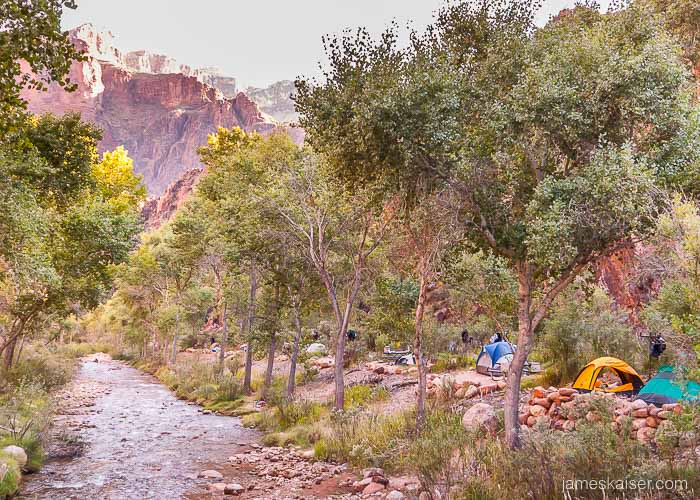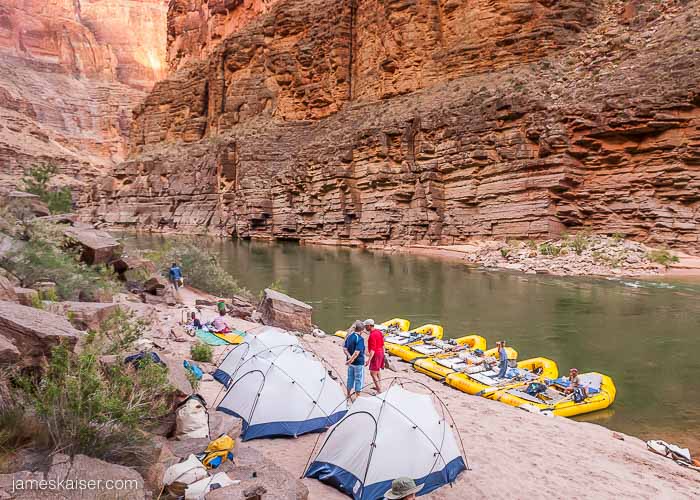
Camping at the bottom of Grand Canyon is one of the most unique experiences in America. The views from the rim are incredible, but the views from the bottom of Grand Canyon are beyond belief. As you gaze upwards, dozens of massive rock formations tower above you on all sides. If it’s spring, the cactus will be blooming; if it’s fall, soft autumn light will illuminate the canyon walls. For those with a love of the natural world, it’s pure sensory overload—thrilling, dizzying, enlightening.
There are several ways to camp at the bottom of Grand Canyon. The easiest and most popular is Bright Angel Campground, which provides drinking water and toilets. Backcountry camping in more rugged areas is also allowed, but you’ll need permits and familiarity with Grand Canyon hiking. My favorite way to camp at the bottom of Grand Canyon, however, is to book a Colorado River Trip. On a river trip you’ll camp on the banks of the Colorado River every single night.
See Also:
Grand Canyon South Rim Camping
Grand Canyon North Rim Camping
Camping at the Bottom of Grand Canyon

Bright Angel Campground
Bright Angel Campground is the only established campground at the bottom of Grand Canyon. It is, in my opinion, the best campground in Grand Canyon National Park. Located about half a mile from the Colorado River, it provides a camping experience unlike any other in the park.
Bright Angel Campground is perched above Bright Angel Creek, whose cool waters provide welcome relief during the hot summer months. Drinking water and toilets are available. Phantom Ranch, a collection of overnight cabins, is located a short distance from Bright Angel Campground, and it includes a cantina where you can purchase ice cream and cold beer!
Because Bright Angel Campground is located at an elevation of 2,480 feet (756 meters), summer temperatures often top 100˙F (38˙C). My favorite time to visit is spring, when wildflowers are blooming and temperatures are relatively mild. Fall is also a good time to visit.
From the South Rim, Bright Angel Campground is reached via the Bright Angel Trail or South Kaibab Trail. From the North Rim, Bright Angel Campground is reached via the North Kaibab Trail.
Bright Angel Campground is open year-round.

Backcountry Camping
Backcountry camping involves hiking along backcountry trails, then camping at a remote campsite. You’ll need a backcountry permit, which can sometimes be hard to reserve in advance. The biggest challenge, however, is not overestimating your hiking ability. Each year dozens of hikers are rescued in Grand Canyon. Steep terrain, hot temperatures and limited access to water are far more dangerous than most people think. Without proper hiking experience you can quickly get yourself into trouble.
If you’re new to Grand Canyon hiking, stick to one of the popular “Corridor Trails,” which are more developed and popular than other hiking trails. The three Corridor Trails are the Bright Angel Trail, South Kaibab Trail and North Kaibab Trail. These trails are the best way to access Grand Canyon’s three established backcountry campgrounds.
Grand Canyon Campgrounds Below the Rim
Bright Angel Campground
Bright Angel Campground is the only established campground at the bottom of Grand Canyon. Located at an elevation of 2,480 feet (756 meters), it offers drinking water and toilets. Open year-round.
Havasupai Gardens Campground
Located halfway down the Bright Angel Trail – 3,000 feet (914 meters) below the South Rim – Havasupai Gardens is a welcome rest stop for weary hikers. A small creek runs through the campground, sustaining tall, shady cottonwood trees planted by pioneers in the early 1900s. Drinking water and toilets are available. Open year-round.
Cottonwood Campground
Located halfway down the North Kaibab Trail, 4,170 feet below the North Rim, Cottonwood Campground makes a great rest stop on the 14-mile journey from the North Rim to Bright Angel Campground. Drinking water is available from mid-May to mid-October. Cottonwood Campground makes a good jumping-off point for day hikes to Roaring Springs, Ribbon Falls, and Manzanita Canyon. Open year-round.
If you’re an experienced backcountry hiker, there are lots of great options for camping at the bottom of Grand Canyon off non-Corridor Trails. Visit Grand Canyon’s backcountry hiking page for more information.

Camping on Colorado River Trips
Nothing — and I mean nothing — reveals the beauty of Grand Canyon like a Grand Canyon River Trip. In addition to thrilling rapids and spectacular hiking, you’ll camp out on the banks of the Colorado River every night. Most campsites are located on beautiful, sandy beaches. As you fall asleep to the sound of the Colorado slowly carving Grand Canyon, billions of stars blaze overhead. There’s no better way to lose yourself—and find yourself.
Camping at the bottom of Grand Canyon on a river trip offers several advantages. For one, you’ll experience a beautiful new campground every night. And as you drift deeper into the heart of Grand Canyon, the campgrounds will become even more spectacular.
Another advantage is that you won’t have to pack in your food and gear. In fact, you’ll have a crew of Grand Canyon experts cooking, cleaning and setting up camp. What better way to experience camping at the bottom of Grand Canyon?


